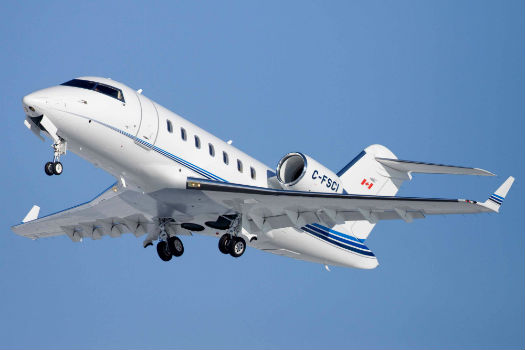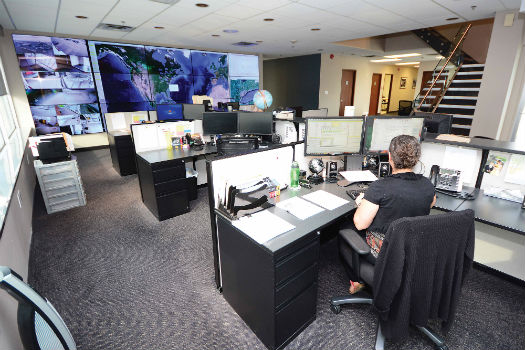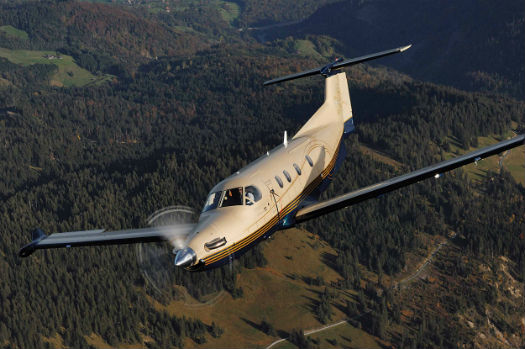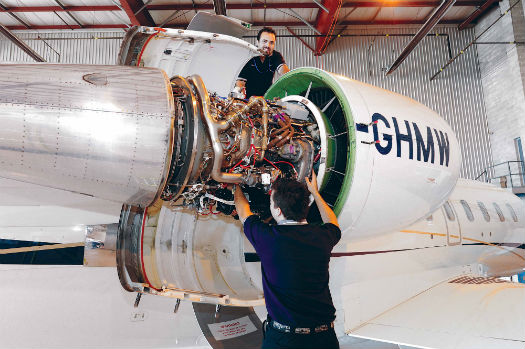There are many aspects of aircraft management. Owners must comply with aviation regulations, purchase insurance, find hangar space, obtain maintenance services, hire flight crew, and provide for flight coordination and planning. Some prefer to handle everything themselves; others would rather hire experts to oversee the process. Michael Durning Photo
Owning an aircraft can be a good business decision for many companies. Some 1,900 corporate aircraft are registered in Canada (three-quarters of them fixed-wing), representing many unique and valid reasons why a company or individual might choose to purchase a business aircraft. While considerations might include convenience, security, privacy, and employee productivity, it’s a simpler calculation from an economic perspective: owning a business aircraft makes sense once a company is already chartering 200 to 250 flight hours per year.
But ownership is not as simple as making the decision to buy. After the aircraft has been purchased, what then? Many operational details must be addressed. Complying with complicated federal aviation regulations is one major concern; but so are more banal issues like buying insurance, finding hangar space, obtaining maintenance services, hiring flight crew, and providing for flight coordination and planning. Collectively referred to as “aircraft management,” every buyer must contend with these facets of ownership.
Rudy Toering, president of the Canadian Business Aviation Association (CBAA), told Skies there are several aircraft management options available—all of which, he added, are endorsed by the industry group.
The first scenario, said Toering, is the owner of a small company who flies and maintains his aircraft.
For larger corporations—and owners without a pilot’s licence—setting up an internal corporate flight department is another option. That usually means hiring a chief pilot to oversee the department and ensure regulatory compliance. The department will typically include flight crew, and may also have dedicated maintenance and operations personnel, although either of those services may be contracted out. Hangar space must be rented or purchased, and other fixed-base operator (FBO) capabilities, like fueling, aircraft handling and de-icing, must be arranged. “That’s the pure business aviation scenario,” said Toering.
About 1,900 corporate aircraft are registered in Canada; three-quarters of those are fixed-wing. Jan Jasinski Photo
And then there is a third aircraft management option, Toering added. “You have the people that get into business aviation who say, ‘Look, I only have to use that airplane at maybe 60 per cent capacity, and I’d like to get some return for the other 40 per cent. Instead of it sitting in the hangar empty, I’d like to charter it out and get some returns.’” For that, owners can turn to a third-party aircraft management firm.
In Canada, there are numerous companies that provide turnkey aircraft management solutions. They take care of all the same operational details as an internal flight department, and most allow varying levels of personalization, depending on a client’s preferences. Most can also charter out an owner’s aircraft, as Toering pointed out, to help defray the costs of ownership.
Control your destiny
Peter Bing is the chief pilot for the Nova Scotia-based Sobeys supermarket chain. His company’s internal flight department operates an eight-seat Challenger 300 and a seven-seat Astra SPX (now branded as the Gulfstream 100).
“Sobeys goes from coast to coast, so we’re flying right across the country quite regularly to different spots, and into the United States as well,” said Bing. The company puts about 300 hours per year on its 15-year-old Astra, and averages 500 hours per year on the seven-year-old Challenger. A weekly shuttle run to Toronto keeps the Challenger busy, while other trips may call for the smaller and shorter-range Astra. However, Bing added, “With most of our mission profiles, either of the aircraft will work; so really, it depends on availability and maintenance.”
Third-party aircraft management firms provide a full range of services. Eric Dumigan Photo
Sobeys’ flight department, founded in the early 1990s, uses Rockwell Collins’ ARINCDirect for flight planning and FlightSafety International for training, but keeps six pilots, one dispatcher, and three maintenance personnel on staff. Heavy maintenance, including C-checks, is done at manufacturer facilities annually, but most other work is performed internally. The company bases its aircraft and maintenance facilities at the Halifax Stanfield International Airport, but also owns the 5,378-foot runway in Trenton, N.S., where the company is headquartered.
“The airport used to be owned and operated by the town of Trenton,” explained Bing. “We’d have years where the snowplow would go down the runway and destroy all the edge lights.” That doesn’t happen anymore. For Sobeys, full operational control of their aircraft and facilities trumps the simplicity of hiring a dedicated aircraft management company. This control also offers a greater guarantee of security and privacy, something that is a priority for some companies and their executives.
“When you have you own aviation department within the company, you’re able to also incorporate all the company’s operating policies, practices, and philosophies within the flight department,” added Bing. “So, the pilots, for instance, who are flying around the company personnel, are fully integrated and part of that whole culture. They have an opportunity to be part of the success of the company.”
Flight planning and following is a crucial aspect of aircraft management. Eric Dumigan Photo
Manage your business – not your aircraft
For other companies, having direct operational control is considered an unnecessary burden. “It’s a hassle and a cost and a liability for an individual or a corporation to run their own airplane,” commented Ian Darnley, director of business development at Sunwest Aviation, a Calgary-based charter and aircraft management firm. “A lot of people just don’t want to have that on their shoulders, and understandably so. It’s not their area of expertise.”
It is, however, the area of expertise for Sunwest’s 330 employees, who handle 50 aircraft at the company—including 20 that are managed for 10 outside clients.
Besides simplicity, using an aircraft management company can allow an owner to leverage greater buying power, because their aircraft is part of a larger fleet. Preferred rates for things like fuel and pilot training lead to savings that are passed on to owners. There are also advantages in having a deeper pool of personnel, experience and capabilities to draw upon than is possible in a private flight department. Darnley points to having a complete safety management system (SMS) team and backup aircraft as key differentiators.
According to Lyn Shinn, vice president of business development at Skyservice, aircraft management companies can also provide the same high level of accountability and transparency as corporate flight departments. “It’s almost like we’re running a series of miniature private flight departments within Skyservice,” she said. When a customer calls, they deal with the same flight coordinator every time. There is also one point of contact for maintenance, and Skyservice pilots are dedicated to one owner. “We encourage that personal relationship between the flight coordinator and the client,” added Shinn.
Owners are advised to “sweat the details” when it comes to managing their aircraft. For instance, establishing a corporate flight department allows companies to fully integrate pilots into their culture. Pilatus Photo
Skyservice manages about 55 aircraft—the largest being a private Boeing 737—for roughly 50 corporate clients and high net worth individuals across Canada. “You own the aircraft,” Shinn explained. “We manage and operate the aircraft from beginning to end: from hiring and training flight crew, to flight coordination, to insurance, to maintenance, and everything in between.”
The larger aircraft management firms have most major types of business aircraft on their operating certificates already, said Execaire vice president and general manager, Michael Fedele. With over 45 aircraft under management for more than 35 clients throughout the country, Execaire has all the standard operating procedures (SOPs), minimum equipment lists (MELs), and other necessary documentation already created. “They’re already incorporated into our training programs and plans, and with experienced training captains already on staff for all types operated, we can get an aircraft up and running very quickly,” added Fedele.
How fast can an aircraft be flying after purchase? It depends on the aircraft type, and on where it’s coming from—and on government bureaucracy, in the guise of Transport Canada—but when using a management company, many owners can be flying in their new aircraft within two to three months of deciding to buy it. Setting up a private flight department can take six months to a year, said Sobeys’ Bing.
Scheduled and unscheduled maintenance can translate into significant costs and lengthy downtime. Owners need to be realistic about the financial commitment that goes hand in hand with operating an aircraft. Mike Reyno Photo
Once integrated into their fleet, management companies can typically have an aircraft ready to fly with short notice. “All you have to do,” said Shinn, “is pick up the phone and say, ‘I want to go to Teterboro tomorrow. I want to leave at two o’clock in the afternoon, and it will be myself and my partner on the aircraft. We don’t need any catering, but can you have a car for us when we arrive in New York?’ That’s all you need to tell us; everything else will be arranged for you.”
As Darnley puts it, “If you own your own aircraft, it’s pretty simple: You have to have pilots. You have to have maintenance and administration. You have to have insurance. You need to pay for that entire infrastructure whether your plane is here or on its own, and typically we can do more for less.”
“And then the charter is the icing on the cake,” he added. “Obviously, some people have a preference to run their own show, and that’s completely fine. We understand that. However, it’s normally the case that that’s more expensive and more of a hassle.”
Successful aircraft management comes down to one question: how much operational control do you wish to maintain? Mike Reyno Photo
Tailored to your needs
The CBAA’s Toering estimates that 45 to 50 per cent of current business aircraft operators in Canada have some form of internal flight department. New aviation regulations, however, could make it harder to get new corporate flight departments off the ground.
“With the new CARs 604 regulations from Transport Canada [governing private flight departments], the regulatory regime that’s in place for this category of operation is very challenging,” explained Execaire’s Fedele. “There’s an expertise required. And you can certainly build that expertise, but it comes down to a matter of cost-effectiveness. If it’s not your core business, you have to ask yourself, why would you want to go down that road?”
There will always be some who want to retain full operational control. “The better, more established, flight departments that have key personnel who are compliant and are proficient, are doing an exceptional job at all the things that need to be done,” said Bing. They also have flexibility and financial latitude to do things like additional training. And, he claimed, doing it yourself can be cheaper than contracting it out, though the management firms generally dispute this assertion.
For many owners, an aircraft management firm will be the simplest, most headache-free solution. For others who demand higher levels of operational control, flexibility, confidentiality, or security, establishing a corporate flight department may be the best bet. Fortunately, if you own a business aircraft, you probably have the freedom and means to choose.













